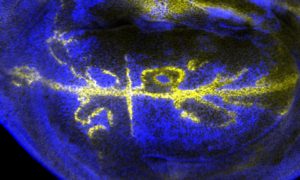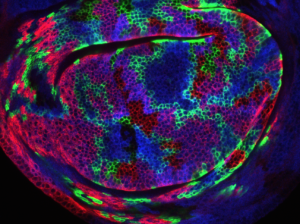
Mechanosensitive ligand/receptor bridges
One way cells communicate is through physical contact. For example a protein on the surface of one cell can act as a signal or ligand and contact its specific receptor on the surface of another cell. A ligand/receptor bridge that links cells in this way can communicate vital information about the position of a cell relative to its neighbors, what sort of function the cell should adopt, whether a cell should begin moving or growing, or whether two neurons should form a synapse. An important bridge that functions in this way involves the Notch receptor. All animals have Notch receptors and they are central to many developmental and physiological processes. Dysregulation of Notch is also the cause of many developmental abnormalities and diseases, including severe forms of cancer. Notch is particularly interesting because it is a mechanosensitive receptor: When ligand makes contact with Notch, it ‘pulls’ on the receptor and initiates receptor activation. We are exploring ligand/receptor bridges like these in vivo using the powerful Drosophila tools I have developed to manipulate ligand/receptor interactions. The work has the potential to shed further light on the activation of the Notch receptor and reveal general principles that will be applicable to ligand/receptor bridges formed by other proteins and in many different contexts.
Developing a platform for engineering customizable cell-cell signaling in vivo
Our work has potential future applications in synthetic biology. Synthetic biology combines biological and engineering principles to regulate cellular processes, and is emerging as an important area of biomedical research. What is needed is a genetically tractable in vivo platform within which synthetic cell-cell signaling tools can be rapidly created, tested, optimized and diversified, before they are deployed and further refined in systems that have therapeutic and biotechnological applications. We aim to fulfill this requirement by establishing a Drosophila system for designing synthetic intercellular signaling that controls tissue behavior.
Drosophila – the awesome power of the fruit fly
Drosophila research is important and highly relevant to human health. A total of 10 Nobel prizes have been awarded for scientific advances using the fly, most recently in 2017. We use the fruit fly Drosophila melanogaster to genetically dissect how cells signal to each other. Many cell-signaling components were first identified in the fly, including the Notch receptor. The original Notch mutation was identified over 100 years ago by Thomas Morgan working in the first fly room at Columbia University. Since this time, superb molecular and genetic tools have been developed for fly biologists. We primarily study signals sent within the fly wing, since this is an exceptionally well-defined epithelial tissue in which an ever improving tool kit of genetic techniques allow signaling events and receptor/ligand interactions to be monitored with cellular and even subcellular precision.


